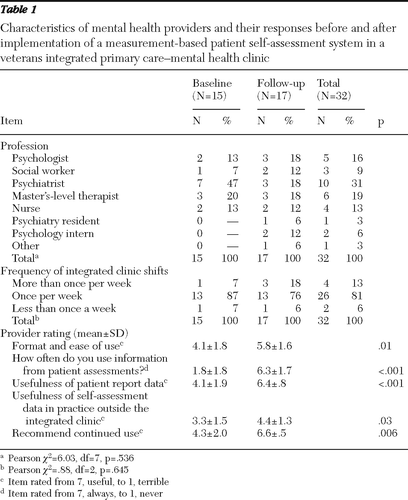Usefulness of Symptom Feedback to Providers in an Integrated Primary Care-Mental Health Care Clinic
Abstract
Objective:
Measurement-based care has been endorsed but not embraced in mental health settings. There is currently little guidance regarding the best methods to implement measurement-based care.
Methods:
A survey of mental health providers was conducted before (N=15) and after (N=17) the implementation of a patient self-report symptom measurement system.
Results:
At baseline, respondents rarely used the patient self-assessment information (mean±SD=1.8±1.8); they reported the patient data to be marginally useful (4.1±1.9), and only slightly recommended the use of patient assessments (4.3±2.0). Possible scores ranged from 1 to 7, with higher scores indicating more positivity. At follow-up, respondents almost always used the information in the assessments (6.3±1.7), found the patient report data very useful (6.4±.8), and highly recommended continued use of patient surveys in the integrated clinic (6.6±.5).
Conclusions:
Providers' lack of enthusiasm about integration of routine data collection and reporting of patient symptoms may be overcome by simply exposing providers to this process. (Psychiatric Services 63:91–93, 2012)
Measurement-based care is defined as the use of standardized quantitative measurement of patient symptoms to guide clinical decision making (1). Measurement-based care has been found to improve patient outcomes when introduced into clinical practice (2). Recent work has suggested various strategies for implementing measurement-based care (1,3,4). This evidence-based practice has been used successfully in mental health care (4–8); however, studies demonstrate that its implementation is not widespread (8). Previous work suggests that mental health care providers have been resistant to use a standardized symptom measurement tool, resulting in wide variation in clinical practices (9). As evidence-based treatment guidelines have been developed and adopted in mental health settings, some have attempted to implement measurement-based care in routine practice (10). However, the implementation of measurement-based care has not been easy; many providers are still resistant to changing their practice patterns (9).
The objective of this study was to determine mental health providers' perceived value of patients' self-reported mental health symptom measurement and measurement-based care. Furthermore, we sought to explore how exposure to mental health symptom measures would affect providers' perceived value of the measure.
Methods
This project was carried out at the White River Junction Veterans Affairs (WRJ VA) medical center, which is a 60-bed hospital (including medical, surgical, intensive care, and mental health care units) that also offers a myriad of outpatient services (primary care, surgery, medical subspecialties, pharmacy, occupational and rehabilitation services, social services, vision and hearing services, and so on). It is one of eight VA medical centers (and 42 associated community-based outpatient centers) in the Veterans Integrated Service Network located in New England.
In 2004, the WRJ VA reconfigured its patient evaluation process as part of a quality improvement effort to improve access to mental health care (11). The newly designed clinic was based on several models of integrated mental health and primary care. Many of those models advocate the use of a robust system for measurement of patient symptoms, and in 2005 the WRJ VA implemented the facilitated use of measurement-based care in the integrated primary care-mental health clinic. Standardized measures were collected from patients with the use of a tablet computer just prior to seeing the provider at each visit. The assessment included the Beck Depression Inventory (12), the PTSD Checklist (13), the Spielberger State-Trait Anxiety Inventory (14), and the Medical Outcomes Study 36-item Short Form (mental and physical component summaries) (15). On completion of the symptom assessment, a standardized symptom report, described in other work (11), was printed and made available to the provider for review before or during the clinic visit. The results of the assessment were entered into the electronic medical record by the provider as part of the notes template.
As part of this project, providers were surveyed about their opinions of the measurement process and instruments used in the integrated mental health and primary care clinic. All providers (including psychiatrists, psychologists, therapists, nursing staff, and other professional staff) involved in the integrated clinic were surveyed. The survey inquired about the usefulness of patient data provided prior to the implementation of measurement-based care and again six months after the implementation had occurred. This project was approved by the Dartmouth institutional review board, and participants gave informed consent.
Results
The type of providers responding to the baseline (N=15, 75% response rate) and follow-up (N=17, 85% response rate) surveys did not differ significantly by type of profession. Similarly, the frequency at which the providers were scheduled at the clinic did not differ between baseline and follow-up (Table 1). Using a 7-point scale response scale (1, terrible or never, to 7, useful or always), providers answered a series of questions about the presentation and usefulness of patients' self-assessment information, including, How would you rate the format or ease of use and understanding of the surveys? How often do you use information from patients' assessments? How useful do you find the patient report data? How often do you use patient report data in your VA practice outside the integrated clinic? How would you rate the usefulness you get from the surveys? and Would you recommend the integrated clinic continue to use patient surveys?
At baseline, respondents rarely used the information presented in the patient assessments (mean±SD=1.8±1.8), and they reported the format (4.1±1.8) and usefulness of the patient report data (4.1±1.9) to be marginal. Similarly, they would only slightly recommend the use of patient surveys at baseline (4.3±2.0). At follow-up, respondents almost always used the information presented in the patient assessments (6.3±1.7), they reported that they found the format (5.8±1.6) and content (6.4±.8) of the patient report data to be very useful, and they highly recommended continued use of patient surveys in the integrated clinic (6.6±.5). As shown in Table 1, comparisons between all baseline and follow-up questions yielded significant differences (p<.05). Of note is that neither the measures nor format of the report was modified between baseline and follow-up. In addition, no provider training on how to interpret the measures or implementation assistance was used.
Discussion
This work provides important clues to successful implementation of measurement-based care in mental health. Providers who had not been exposed to measurement-based care perceived it to be unhelpful, whereas the same providers found it highly valuable after brief exposure to it. Despite the enthusiasm for measurement-based care in the study clinic, there was only a small increase in the percentage of providers who reported that they used the measurement tools in their VA practice outside the project setting (from 20% to 23%). This suggests that developing a system of care that routinely collects patient data and reports it to providers in a timely, easy-to-interpret format may be the most important factor in implementing measurement-based care. A supportive environment that will assist with the logistics of the assessment and reporting (including patients' use of a touch pad and the printing of the reports and placement in the patient file) appears to be imperative to successful implementation. Furthermore, this work suggests that providers' lack of enthusiasm about integration of routine collection and reporting of patient symptoms may be a less important factor in implementing measurement-based care. Our findings indicated that this barrier was overcome by simply exposing providers to a measurement-based system.
This study was not without limitations. It was conducted at a small, rural VA medical center involving a limited number of staff, and the findings may not be generalizable to other integrated primary care-mental health clinics.
Conclusions
This study showed that mental health providers who had not been exposed to validated, standardized patient self-report instruments about symptoms asserted they would not find the information useful and reported a low rate of use in practice. However, after a brief exposure to the standardized assessment tool in this clinical setting, the same providers reported the information to be very useful and recommended that it be continued.
1 : Measurement-based care in psychiatric practice: a policy framework for implementation. Journal of Clinical Psychiatry 72:1136–1143, 2011 Crossref, Medline, Google Scholar
2 : Implementing standardized assessments in clinical care: now's the time. Psychiatric Services 60:1372–1375, 2009 Link, Google Scholar
3 : Clinical results for patients with major depressive disorder in the Texas Medication Algorithm Project. Archives of General Psychiatry 61:669–680, 2004 Crossref, Medline, Google Scholar
4 : Depression, IV: STAR*D treatment trial for depression. American Journal of Psychiatry 160:237, 2003 Link, Google Scholar
5 : Sequenced Treatment Alternatives to Relieve Depression (STAR*D): rationale and design. Controlled Clinical Trials 25:119–142, 2004 Crossref, Medline, Google Scholar
6 : Evaluation of outcomes with citalopram for depression using measurement-based care in STAR*D: implications for clinical practice. American Journal of Psychiatry 163:28–40, 2006 Link, Google Scholar
7 : STAR*D: what have we learned? American Journal of Psychiatry 164:201–204, 2007 Link, Google Scholar
8 : Can phase III trial results of antidepressant medications be generalized to clinical practice? A STAR*D report. American Journal of Psychiatry 166:599–607, 2009 Link, Google Scholar
9 : Measurement-based care for refractory depression: a clinical decision support model for clinical research and practice. Drug and Alcohol Dependence 88:S61–S71, 2007 Crossref, Medline, Google Scholar
10 : Improving depression care in a psychiatry resident psychopharmacology clinic: measurement, monitoring, feedback and education. Quality and Safety in Health Care 19:234–238, 2010 Crossref, Medline, Google Scholar
11 : The White River model of co-located collaborative care: a platform for mental and behavioral health care in the medical home. Family Systems and Health 28:114–129, 2010 Crossref, Medline, Google Scholar
12 : An inventory for measuring depression. Archives of General Psychiatry 4:561–571, 1961 Crossref, Medline, Google Scholar
13 : The diagnostic accuracy of the PTSD Checklist: a critical review. Clinical Psychology Review 30:976–987, 2010 Crossref, Medline, Google Scholar
14 : Manual for the State-Trait Anxiety Inventory. Palo Alto, Calif, Consulting Psychologists Press, 1983 Google Scholar
15 : The MOS 36-item Short-Form Health Survey (SF-36): I. conceptual framework and item selection. Medical Care 30:473–483, 1992 Crossref, Medline, Google Scholar
Figures and Tables

Table 1 Characteristics of mental health providers and their responses before and after implementation of a measurement-based patient self-assessment system in a veterans integrated primary care-mental health clinic



